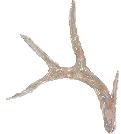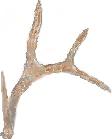Kerr WMA: Deer Research Projects
Antler Development in the Progeny of Nutritionally Stressed Yearling Spike Sires (1999-2006; Phase I and II)


This study will investigate and compare phenotypic antler characteristics of progeny sired by large antlered adult male white-tailed deer that were spike-antlered yearlings to progeny from fork-antlered yearling sires. Using pedigree records, 3 mature males were selected as sires. These males were nutritionally stressed spikes as yearlings, and exhibit the highest gross Boone and Crockett scores at 4.5 years of age of all bucks that were spikes as yearlings. There are 3 single-sire breeding pens with dams from previous studies that have consistently produced male offspring with multi-point yearling antlers. Breeding herds consist of 1 buck and 8-12 does to be maintained in 4 2/3-acre pens on the Kerr WMA. Data from all yearling progeny are collected in October, including body weight, antler weight, spread, main beam basal circumference and length, and number of points. DNA samples are being collected and stored at Texas A&M University for future genetic analysis. Resultant data will be used to conduct a comparative analysis with results obtained from the previous breeding study in which the same dams were bred to nutritionally stressed multi-point yearling sires. The final analysis will be conducted when this cohort reaches 4.5 years of age. For additional comparative purposes, Phase II of this project will involve a similar breeding experiment. These same dams will again be bred to large-antlered adult males that were spikes as yearlings but were not nutritionally stressed. These selected males were produced by Buck 89-10, a large-antlered non-typical (GBC of 190+) and spike-line dams. These breeding experiments will allow us to compare phenotypic antler characteristics of male progeny from large antlered males that were spike antlered yearlings to progeny from large-antlered males that were multi-point yearlings utilizing the same pedigreed doe herd. The results of this study will indicate whether these sires "breed true" (i.e. will they produce all large antlered male offspring, all small-antlered offspring, or progeny exhibiting a combination of antler characteristics). The results of these breeding will then be compared to offspring from the last breeding associated with the Genetic and Environmental Interaction Study.